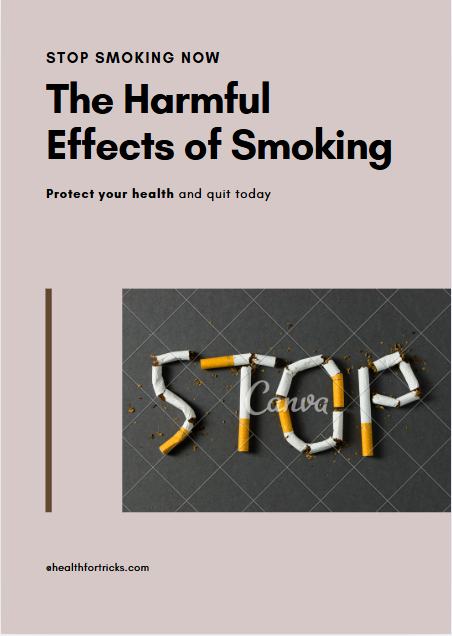The harmful effects of Smoking is one of the leading causes of preventable death worldwide. Despite widespread awareness that smoking is harmful to health, millions of people continue this dangerous habit. The addictive nature of nicotine not only hooks people but also slowly damages multiple organs in the body.
The harmful effects of smoking artical, we will explore the health risks associated with smoking, how it affects various parts of the body, and effective ways to quit smoking for a healthier life.
Why Smoking is So Dangerous
With over 7,000 toxic chemicals, the harmful effects of smoking impact nearly every organ in the human body.
1. Increased Risk of Cancer
Smoking significantly raises the risk of developing various types of cancer, including:
- Lung cancer – Over 80% of lung cancer cases are directly linked to smoking.
- Oral cancer – Including cancer of the tongue, lips, and throat.
- Esophageal and stomach cancer – Harmful chemicals enter the digestive system through inhaled smoke.
- Bladder and kidney cancer – Carcinogens absorbed into the bloodstream impact internal organs.
Avoiding smoking is the most effective way to prevent these devastating diseases.
2. Heart Disease and Stroke
Nicotine in cigarettes causes blood vessels to narrow and harden, making it difficult for blood to flow freely. This increases the risk of:
- High blood pressure
- Heart attacks
- Blood clots
- Strokes
Smokers are two to four times more likely to develop coronary heart disease than non-smokers. One of the most dangerous harmful effects of smoking is its impact on the cardiovascular system.
3. Reproductive and Pregnancy Issues
Smoking negatively affects fertility and pregnancy for both men and women:
- In men, it lowers sperm count and quality, reducing chances of conception.
- In women, it increases the risk of miscarriage, ectopic pregnancy, and low birth weight.
- Babies born to mothers who smoke may face developmental delays, respiratory issues, and even sudden infant death syndrome (SIDS).
4. Skin and Appearance Damage
Smoking affects blood circulation to the skin, reducing oxygen supply and vital nutrients. As a result:
- Skin becomes dull, dry, and lifeless
- Premature wrinkles and fine lines appear, especially around the mouth and eyes
- Yellow stains on teeth and fingers become noticeable
- Hair becomes brittle and may fall out
Long-term smokers often appear older than their actual age due to these effects.

7 Harmful Effects of Smoking
Quitting smoking isn’t easy, but it’s absolutely possible with the right strategy and mindset. Here are some practical and proven methods to help you succeed:
1. Identify Your Triggers
Figure out what situations or emotions prompt you to smoke, such as:
- Drinking tea or coffee
- Stress or anxiety
- Social gatherings or peer pressure
Avoid or modify these triggers where possible.
2. Replace the Habit
Keep your hands and mouth busy with healthier alternatives:
- Chewing gum
- Drinking water
- Eating fruits or nuts
- Using a stress ball or fidget tool
3. Exercise Regularly
Physical activity helps reduce nicotine cravings and improves mood. Even a 30-minute walk can:
- Boost your energy
- Clear your lungs
- Reduce stress hormones
- Build your confidence to stay smoke-free
4. Practice Deep Breathing and Meditation
Stress is a common reason people smoke. Replace that coping mechanism with:
- Deep breathing exercises
- Yoga or mindfulness meditation
- Listening to calming music
These help calm your mind and reduce the urge to smoke .Few people realize that the harmful effects of smoking extend to fertility and unborn babies as well.
5. Get Rid of Smoking Items
Remove all reminders of your smoking habit:
- Throw away cigarettes, lighters, and ashtrays
- Clean your clothes and home to remove smoke odor
- Avoid areas where smoking is common
6. Don’t Be Discouraged by Relapse
It’s normal to fail once or even several times while trying to quit. What matters most is:
- Trying again
- Learning from mistakes
- Building stronger habits over time
Health Benefits of Quitting Smoking
Once you stop smoking, your body begins to heal almost immediately:
- After 20 minutes: Heart rate and blood pressure begin to drop
- After 12 hours: Carbon monoxide levels in the blood return to normal
- After 1–9 months: Coughing and shortness of breath decrease
- After 1 year: Risk of heart disease is cut in half
- After 10 years: Risk of lung cancer drops significantly
The sooner you quit, the more years you can add to your life!
The harmful effects of smoking are undeniable and impact nearly every part of the human body. From increasing the risk of cancer and heart disease to causing reproductive issues and premature aging, smoking takes a heavy toll on both physical and mental health. The sooner you quit smoking, the quicker your body begins to heal and repair itself.
By understanding the harmful effects of smoking clearly, you empower yourself to make healthier choices. Quitting smoking is the single most important step you can take to protect your health and improve your quality of life. Remember, it’s never too late to quit and start experiencing the benefits of a smoke-free life.
Take the first step today—your body and mind will thank you for overcoming the dangerous and destructive harmful effects of smoking.
